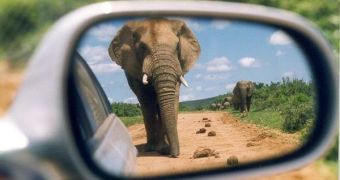Elephants are not exactly among the stealthiest of animals. In fact, they are fairly large and easy to spot. So, one could ask themselves why it is difficult to number them. The answer is very easy. The pachyderms cover hundreds of miles of land inside parks, and move around over great distances each day. Tracking them down thus becomes very expensive, and requires a lot of manpower to perform. All of these are in short supply in developing countries, so scientists propose installing microphones in the wild to track them down, Wired reports.
The acoustical-monitoring technique is derived from programs meant to count birds after individual songs, but it's highly adapted for land use. The team of scientists behind it, which is based at the Cornell University, believes that installing microphones along natural reserves and using specialized software to recognize each individual voice may be a lot cheaper and more effective to do in the long run than driving around over hundreds of miles looking for the beasts. The jungles of Central Africa are also a bit difficult to navigate through, especially via jeeps or other vehicles.
The Elephant Listening Project is described in more detail in the September issue of the African Journal of Ecology. The method for determining where to install the microphones is fairly easy. The CU team described, for example, its experiences at a Central African Republic site. There, it observed the clearings in the forests where elephants were known to gather, and then counted the animals it encountered and recorded the noises they made. This data provided it with a sustainable framework for future interpretations of the sounds it recorded afterwards. A net of microphones was then installed in the jungle, able to pick up elephant “voices.”
The researchers note that this type of approach “provides an opportunity to improve management and conservation of many acoustically active taxa whose populations are currently under-monitored.” The main advantage that microphones have over regular observation methods is the fact that they are able to provide detailed ecological snapshots, in that they can count virtually anything that makes a sound. Additionally, each of the acoustic devices covers a square mile, which is “a dramatic increase in coverage over dung survey transects,” the experts conclude.

 14 DAY TRIAL //
14 DAY TRIAL //